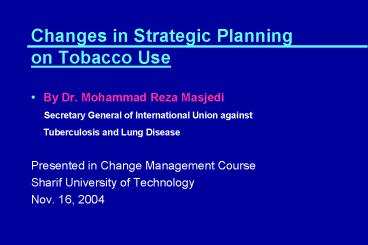Changes in Strategic Planning on Tobacco Use - PowerPoint PPT Presentation
1 / 16
Title:
Changes in Strategic Planning on Tobacco Use
Description:
Secretary General of International Union ... Aortic aneurysm. Atherosclerotic peripheral vascular disease ... Each year tobacco kills 5 million people worldwide ... – PowerPoint PPT presentation
Number of Views:39
Avg rating:3.0/5.0
Title: Changes in Strategic Planning on Tobacco Use
1
Changes in Strategic Planning on Tobacco Use
- By Dr. Mohammad Reza Masjedi
- Secretary General of International Union
against - Tuberculosis and Lung Disease
- Presented in Change Management Course
- Sharif University of Technology
- Nov. 16, 2004
2
What is the problem?
- Tobacco Use
3
Why tobacco use is a major problem?
- Health
- Economic
- Social
- Political
4
Tobacco-Caused Diseases
- Health consequences of tobacco use
- Effect of smoking on mortality
- Overview of the tobacco-caused diseases e.g
- cancer
- chronic obstructive pulmonary disease (COPD)
- cardiovascular disease
- peptic ulcer
- Other diseases under investigation
- Effects on youth
5
Smoking-Caused Diseases
6
Health Consequences of Tobacco Use
- Each year tobacco kills 5 million people
worldwide - WHO estimates that by 20202030, tobacco will be
responsible for 10 million deaths per year - 70 will occur in developing countries
- Half of all long-term smokers will be killed by
tobacco - half of these will die in middle age, losing
2025 years of life
7
Economic Consequences of Tobacco Use
- Use Expense
- Medical costs
- Productivity losses due to
- morbidity
- disability
- premature mortality
- Global net loss of US 300 billion per year
- In Iran 40 billion Rials per day
8
Social
- Smoking is the most common causes of Drug Abuse
and - a major pathway for other social problems
9
US Tobacco Corporations Move Overseas
Tobacco revenues from international
sales 1990 1996 Philip Morris 51billion
66 billion BAT 28billion 44 billion
INFACT, 1998
10
Tobacco Control
- Goals and rationales of tobacco control programs
- Obstacles to tobacco control
- Strategies to reduce demand
- Regulation of tobacco products
- Strategies to reduce supply
- WHO recommendations
- WHO Tobacco Free Initiative
- Framework Convention for Tobacco Control
11
Goal of Tobacco Control Programs
- To reduce the mortality and morbidity caused by
the use of tobacco products
12
Obstacles to Tobacco Control
- Tobacco contains nicotine, which is addictive
- The tobacco industry uses its economic and
political influence to oppose tobacco control
efforts - Tobacco sales contribute to government revenues
- In some populations, there is a lack of knowledge
of tobacco-related health risks
13
Tobacco Control Efforts to Reduce Supply
- Prohibition of tobacco
- Restrictions on youth access
- Crop substitution and diversification
- Restrictions on international trade
- Action against smuggling
14
Summary WHO Recommendations for Comprehensive
Tobacco Control
- Comprehensive national programs should employ
multiple strategies, including fiscal policy,
information policy, establishment of smoke-free
public places and provision of treatment - Adequate support is critical and should include
support for capacity building, applied research,
surveillance and evaluation - Public/media debate on tobacco control-related
issues should be encouraged
15
Framework Convention
- International legal instrument
- Singed by 168 WHO Member States
- Ratification by 40 WHO Member States by end of
2004 - Aim is to improve transnational tobacco control
and cooperation
16
Methods
- National Local Laws
- International FCTC Highlights
- Advertising, Promotion and Sponsorship
- Packaging and Labeling
- Secondhand Smoke
- Smuggling
- Taxation Duty Free Sales
- Product Regulation Ingredient Disclosure































